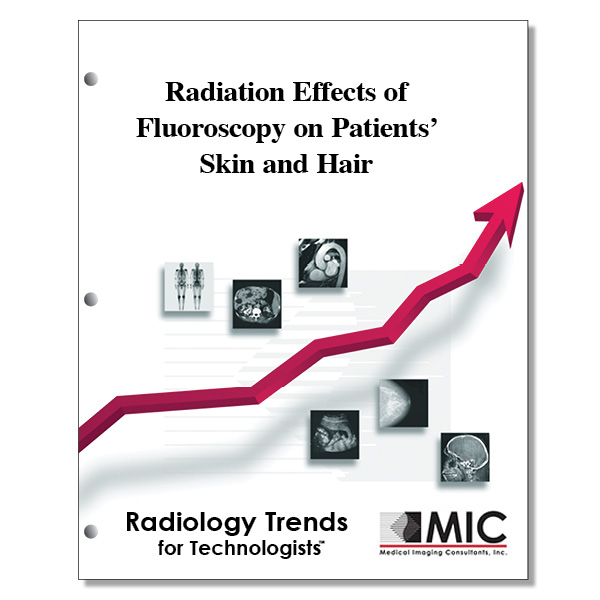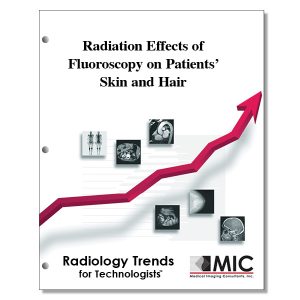

Radiation Effects of Fluoroscopy on Patients’ Skin and Hair
A review of the current data concerning the essential factors regarding radiation effects on patients’ skin and hair. Fluoroscopy guided procedures and radiation therapy are discussed.
Course ID: Q00293 Category: Radiology Trends for Technologists Modalities: Cardiac Interventional, Nuclear Medicine, Radiation Therapy, Radiography, Vascular Interventional3.0 |
Satisfaction Guarantee |
$34.00
- Targeted CE
- Outline
- Objectives
Targeted CE per ARRT’s Discipline, Category, and Subcategory classification for enrollments starting after June 11, 2024:
[Note: Discipline-specific Targeted CE credits may be less than the total Category A credits approved for this course.]
Cardiac-Interventional Radiography: 3.00
Patient Care: 1.50
Patient Interactions and Management: 1.50
Image Production: 1.50
Image Acquisition and Equipment: 1.50
Computed Tomography: 1.50
Safety: 1.50
Radiation Safety and Dose: 1.50
Nuclear Medicine Technology: 2.75
Safety: 2.75
Radiation Physics, Radiobiology, and Regulations: 2.75
Radiography: 3.00
Safety: 3.00
Radiation Physics and Radiobiology: 1.75
Radiation Protection: 1.25
Registered Radiologist Assistant: 3.00
Safety: 3.00
Patient Safety, Radiation Protection, and Equipment Operation: 3.00
Radiation Therapy: 2.75
Safety: 2.75
Radiation Physics and Radiobiology: 1.75
Radiation Protection, Equipment Operation, and Quality Assurance: 1.00
Vascular-Interventional Radiography: 3.00
Patient Care: 1.50
Patient Interactions and Management: 1.50
Image Production: 1.50
Image Acquisition and Equipment: 1.50
Outline
- Introduction
- Background
- Clinical Use of Radiation
- Biologic Factors That Influence Skin Reactions
- Radiobiology of Radiation Injuries
- Initiating Dose and Time Course of Radiation Injury
- Prompt Reactions
- Early Reactions
- Midterm Reactions
- Long-term Reactions
- Time Sequence
- Interaction between Different Types of Damage
- Risk Management of Skin Effects in Interventional Procedures
- Staged and Repeated Procedures
- Discussion
- Appendix
Objectives
Upon completion of this course, students will:
- know the time frame when a noticeable skin change is observed after a peak dose
- be able to recognize the essential factors of radiation effects related to fluoroscopy-guided procedures
- be familiar with steps necessary to manage radiation exposure to patients
- understand that the fluoroscopy time is not a good indicator of skin injury
- be familiar with what factor increases backscatter
- be familiar with the physical and patient-related factors that can affect the expression of skin injury
- be familiar with the body regions that are relatively resistant sites to the development of skin damage
- be familiar with which body regions are the most sensitive sites to the development of skin damage
- be able to recognize disorders associated with increased radio-sensitivity
- be familiar with drugs associated with radiation recall
- recognize an inflammatory skin condition which occurs in a previously irradiated body part after drug administration
- be familiar with the properties of repopulation of skin cells
- be familiar with the organization responsible for defining the 5 grades of skin toxicity
- be familiar with the so-called 24-hour erythematous reaction
- be familiar with reactions observed between 2 and 8 weeks after exposure
- be familiar with reactions observed more than 40 weeks after irradiation
- be able to recognize a long-term reaction resulting from dilation of capillaries more than 52 weeks after irradiation
- be familiar with reactions in which there is development of delayed lesions in the walls of blood vessels in the dermis and subcutaneous fat
- be able to compare a healed wound and non-irradiated skin with regard to potential breakdown
- be familiar with skin dose range associated with A1 dose band scale
- be familiar with recommended advice associated with A2 dose band scale
- be familiar with recommended advice associated with B dose band scale
- be familiar with skin dose range associated with D dose band scale
- be familiar with skin dose range associated with C dose band scale
- be familiar with recommended advice associated with A1 dose band scale
- be familiar with skin dose range associated with B dose band scale
- be familiar with recommended advice associated with C dose band scale
- be familiar with skin dose range associated with A2 dose band scale
- be familiar with recommended advice associated with D dose band scale
- be familiar with the influence of residual effects from previous procedures
- know the best indicator of cumulative skin dose
- recognize how NCI skin toxicity grade 1 manifests in patients
- recognize how NCI skin toxicity grade 2 manifests in patients
- recognize how NCI skin toxicity grade 3 manifests in patients
- recognize how NCI skin toxicity grade 4 manifests in patients
